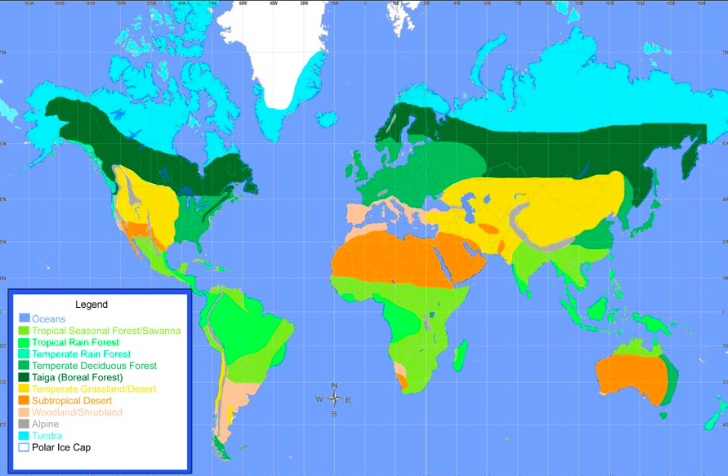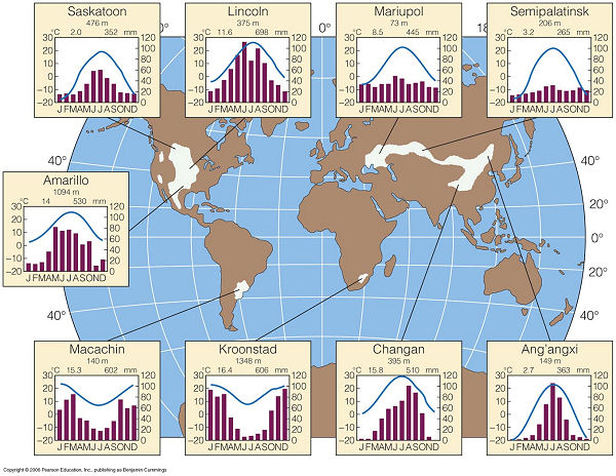Temperate Grassland Temperature Insights

The temperate grasslands, often referred to as prairies in North America, pampas in South America, and steppes in Eurasia, are characterized by their unique blend of grasses and wildflowers. These ecosystems are found in temperate regions and are known for their lack of trees, which is largely due to factors such as low precipitation, frequent fires, and intense grazing by herbivores. One of the defining features of temperate grasslands is their temperature profile, which plays a crucial role in shaping the biodiversity and ecosystem dynamics of these regions.
Temperature Variations in Temperate Grasslands

Temperate grasslands experience a wide range of temperatures throughout the year. The average temperature in these regions varies significantly from summer to winter. During the summer months, the temperature can soar to as high as 30°C (86°F), while in the winter, it can drop to as low as -20°C (-4°F). This fluctuation in temperature has a profound impact on the types of plants and animals that inhabit these regions.
Seasonal Patterns
The seasonal patterns in temperate grasslands are characterized by warm summers and cold winters. The growing season, which typically lasts from April to October, is marked by an increase in temperature and precipitation. This period is conducive to the growth of grasses and wildflowers, which are the primary producers of the ecosystem. The dormant season, which spans from November to March, is marked by cold temperatures and reduced precipitation, resulting in a decrease in plant growth and activity.
Diurnal Patterns
In addition to seasonal patterns, temperate grasslands also exhibit diurnal patterns in temperature. The temperature typically rises during the day, reaching its peak in the late afternoon, and then drops at night. This diurnal variation in temperature has a significant impact on the behavior and physiology of the plants and animals that inhabit these regions.
Impact of Temperature on Ecosystem Dynamics

The temperature profile of temperate grasslands has a profound impact on the ecosystem dynamics of these regions. The types of plants and animals that inhabit these regions are adapted to the specific temperature conditions, and any changes in temperature can have far-reaching consequences.
Plant Growth and Development
The growth and development of plants in temperate grasslands are closely tied to the temperature profile. The warm temperatures during the growing season stimulate the growth of grasses and wildflowers, while the cold temperatures during the dormant season induce dormancy. Any changes in temperature, such as an increase in temperature due to climate change, can alter the timing of plant growth and development, which can have cascading effects on the entire ecosystem.
Animal Behavior and Physiology
The temperature profile of temperate grasslands also has a significant impact on the behavior and physiology of the animals that inhabit these regions. Many animals, such as birds and insects, migrate to warmer regions during the winter months to escape the cold temperatures. Others, such as prairie dogs and rabbits, adapt to the cold temperatures by changing their behavior, such as burrowing underground or thickening their coats.
Temperature-Related Challenges in Temperate Grasslands
Temperate grasslands are facing several temperature-related challenges, including climate change, drought, and heatwaves. These challenges have the potential to alter the ecosystem dynamics of these regions, leading to changes in plant and animal populations, and potentially even extinctions.
Climate Change
Climate change is one of the most significant temperature-related challenges facing temperate grasslands. The increase in temperature due to climate change is altering the timing of plant growth and development, which can have cascading effects on the entire ecosystem. For example, the earlier onset of spring can lead to a mismatch between the timing of plant growth and the arrival of pollinators, such as bees and butterflies.
Drought
Drought is another significant temperature-related challenge facing temperate grasslands. The lack of precipitation during droughts can lead to a decrease in plant growth and productivity, which can have a cascading effect on the entire ecosystem. For example, the decrease in plant growth can lead to a decrease in the population of herbivores, such as deer and prairie dogs, which can then lead to a decrease in the population of predators, such as coyotes and hawks.
Heatwaves
Heatwaves are also a significant temperature-related challenge facing temperate grasslands. The extreme temperatures during heatwaves can lead to a decrease in plant growth and productivity, as well as an increase in mortality rates among animals. For example, the heatwave of 2012 in the United States led to a significant decline in the population of corn and soybeans, which are two of the most important crops in the region.
Conclusion
In conclusion, the temperature profile of temperate grasslands plays a crucial role in shaping the biodiversity and ecosystem dynamics of these regions. The unique blend of grasses and wildflowers in these ecosystems is adapted to the specific temperature conditions, and any changes in temperature can have far-reaching consequences. The temperature-related challenges facing temperate grasslands, including climate change, drought, and heatwaves, have the potential to alter the ecosystem dynamics of these regions, leading to changes in plant and animal populations, and potentially even extinctions. Therefore, it is essential to understand the temperature profile of temperate grasslands and the impact of temperature on ecosystem dynamics to develop effective conservation and management strategies for these regions.
What is the average temperature in temperate grasslands during the summer months?
+The average temperature in temperate grasslands during the summer months can range from 20°C to 30°C (68°F to 86°F).
How does the temperature profile of temperate grasslands impact the types of plants and animals that inhabit these regions?
+The temperature profile of temperate grasslands has a significant impact on the types of plants and animals that inhabit these regions. The warm temperatures during the growing season stimulate the growth of grasses and wildflowers, while the cold temperatures during the dormant season induce dormancy. The unique blend of grasses and wildflowers in these ecosystems is adapted to the specific temperature conditions, and any changes in temperature can have far-reaching consequences.
What are some of the temperature-related challenges facing temperate grasslands?
+Some of the temperature-related challenges facing temperate grasslands include climate change, drought, and heatwaves. These challenges have the potential to alter the ecosystem dynamics of these regions, leading to changes in plant and animal populations, and potentially even extinctions.
In the context of temperate grasslands, understanding the temperature profile and its impact on ecosystem dynamics is essential for developing effective conservation and management strategies. The unique blend of grasses and wildflowers in these ecosystems is adapted to the specific temperature conditions, and any changes in temperature can have far-reaching consequences. By examining the temperature-related challenges facing temperate grasslands and their impact on ecosystem dynamics, we can gain a deeper understanding of the complex interactions that shape these regions and develop strategies to mitigate the effects of climate change, drought, and heatwaves.
The interplay between temperature, plant growth, and animal behavior is a critical component of temperate grassland ecosystems. The warm temperatures during the growing season stimulate the growth of grasses and wildflowers, while the cold temperatures during the dormant season induce dormancy. This cycle of growth and dormancy is essential for the survival of the plants and animals that inhabit these regions. However, changes in temperature due to climate change, drought, and heatwaves can disrupt this cycle, leading to changes in plant and animal populations, and potentially even extinctions.
To develop effective conservation and management strategies for temperate grasslands, it is essential to understand the complex interactions between temperature, plant growth, and animal behavior. This requires a comprehensive approach that takes into account the unique characteristics of these ecosystems and the impact of temperature on ecosystem dynamics. By examining the temperature profile of temperate grasslands and its impact on ecosystem dynamics, we can gain a deeper understanding of the complex interactions that shape these regions and develop strategies to mitigate the effects of climate change, drought, and heatwaves.
Temperate grasslands are complex ecosystems that are shaped by a unique blend of temperature, plant growth, and animal behavior. The interplay between these factors is critical for the survival of the plants and animals that inhabit these regions. By understanding the temperature profile of temperate grasslands and its impact on ecosystem dynamics, we can develop effective conservation and management strategies that take into account the unique characteristics of these ecosystems.
In conclusion, the temperature profile of temperate grasslands plays a crucial role in shaping the biodiversity and ecosystem dynamics of these regions. The unique blend of grasses and wildflowers in these ecosystems is adapted to the specific temperature conditions, and any changes in temperature can have far-reaching consequences. By examining the temperature-related challenges facing temperate grasslands and their impact on ecosystem dynamics, we can gain a deeper understanding of the complex interactions that shape these regions and develop strategies to mitigate the effects of climate change, drought, and heatwaves.
Developing Effective Conservation and Management Strategies for Temperate Grasslands

- Understand the temperature profile of temperate grasslands and its impact on ecosystem dynamics
- Examine the temperature-related challenges facing temperate grasslands, including climate change, drought, and heatwaves
- Develop a comprehensive approach that takes into account the unique characteristics of these ecosystems and the impact of temperature on ecosystem dynamics
- Implement strategies to mitigate the effects of climate change, drought, and heatwaves, such as reducing greenhouse gas emissions and implementing sustainable land-use practices
By following these steps, we can develop effective conservation and management strategies for temperate grasslands that take into account the unique characteristics of these ecosystems and the impact of temperature on ecosystem dynamics. This will require a collaborative effort between scientists, policymakers, and land managers to develop and implement strategies that mitigate the effects of climate change, drought, and heatwaves and promote the conservation of these critical ecosystems.
